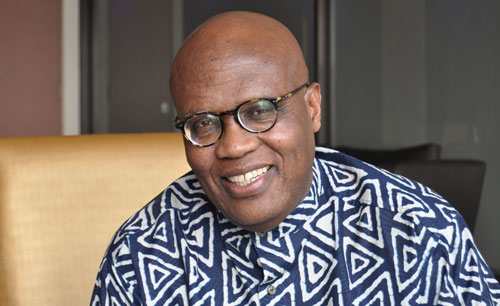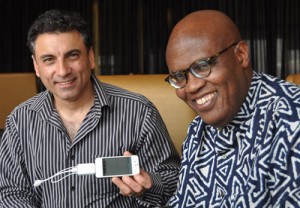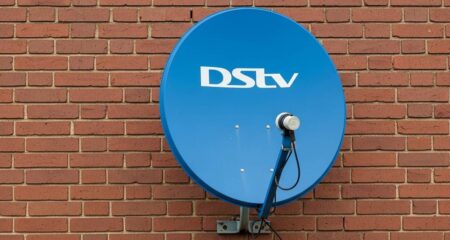
Mobile TV, the company planning to introduce mobile television services in SA using Korea’s digital multimedia broadcasting (DMB) standard, says it could be ready to start broadcasting commercially within three months in Gauteng.
It is also planning to introduce SA’s first digital audio broadcasting (DAB) radio stations — seen potentially as an eventual replacement to FM radio — as well as “visual radio” services, which offer visuals over normal radio broadcasts.
Mobile TV founder and chairman Mothobi Mutloatse says the company is itching to get a commercial licence from the Independent Communications Authority of SA (Icasa) so it can launch services. It currently has a 12-month test licence, which expires at the end of November. It’s been running a pilot broadcast from the Sentech tower in Brixton, Johannesburg.
It has produced two technical reports for Icasa, one using a 600W transmitter and another using 2 000W equipment. The test frequency is in the VHF band, with transmission equipment provided by Harris.
“We have submitted the first of several processes towards the permanent licence application using the same frequency on VHF, which is the most appropriate for mobile television broadcasting,” Mutloatse says.
If Icasa gives it the go-ahead, Mobile TV will be the second company to offer mobile television in SA after MultiChoice introduced DStv Mobile earlier this year in partnership with e.tv.
MultiChoice uses a rival technology to DMB called digital video broadcasting handheld, or DVB-H, developed in Europe, but Mutloatse claims DMB is the superior technology. Mobile TV was recently appointed to the steering committee of the International DMB Advancement Group, which comprises members from 14 countries.

Mobile TV has partnered with a company called Hi-Tech Audio, which has exclusive rights to the DMB technology in SA. Its MD, Kevin Manas, says Mobile TV’s tests have shown it can broadcast at distances of up to 70km from the broadcast tower using VHF spectrum. The test transmitter is providing broadcasts across the greater Johannesburg area.
Mutloatuse says Mobile TV plans to introduce a range of DMB access devices in the SA market, including tablets and mobile phones — most of them of Korean origin. It also plans to offer an adapter/receiver for the iPhone, iPad and iPod touch that allows users of the Apple devices to watch television and listen to radio on the go. (TechCentral is testing the adapter and will bring its readers a review soon.)
The company is also investigating devices that can be fitted in taxis that will offer programming and targeted advertising to commuters.
Mutloatse is confident Mobile TV will be successful in its application for a licence. “When the first licences were issued, it was on the understanding that there would be a second phase that would include those that did not receive a licence [in the first round],” he says. “Icasa hasn’t told us when the second phase will happen but we are engaging with them because we want to fast-track this.”
The company also plans to offer SA’s first digital radio broadcasts using DAB as well as visual radio products. “We were the first to introduce visual radio with MetroFM,” he says. “We believe this will turn commercial radio into a new experience [because] it implies there could be station ID, artist ID, visual imagery and running text of current news.”
MetroFM and 5fm, both SABC radio stations, have formed part of Mobile TV’s trial, with 5fm available using DAB.
During the test phase, the company has access to one block of frequency. It hopes to get three blocks to launch commercial services, which would allow it to provide six television channels and six visual radio channels, with half of each offering interactive services like games via a mobile return path.
Asked how long Mobile TV would need to build its network, Mutloatse says the company will focus first on Gauteng by building three transmitters, one in Johannesburg, one in Pretoria and the third in the south of the province. It will then roll out services to KwaZulu-Natal, the Western Cape, the Free State, Limpopo, Mpumalanga, the Eastern Cape and North-West. “Within 18 months, we will have national coverage and 19 sites,” he says. “Within a year, we should have reached 43% population coverage.”
The national high sites will be provided by Sentech. The company has also begun talks with the mobile operators about offering services through their networks.
Mutloatse is reluctant to talk about the company’s financial backers and shareholders, saying a restructuring is underway that must still be approved by the board of directors. He reveals that the investment arm of the Communication Workers Union is taking a stake.
He says it’s also too early to reveal what channels it plans to offer, but he hints that Mobile TV may work with government to offer educational channels on a regional level. The main target market for the service will be people in living standards measures six to eight. — Duncan McLeod, TechCentral
- Subscribe to our free daily newsletter
- Follow us on Twitter or on Facebook




